Higashiyama & Kazuemachi Area
Along the banks of the Asano River lie two of Kanazawa’s most scenic districts — Higashi Chaya-gai and Kazuemachi Chaya-gai. Within the soft interplay of latticed wooden façades and cobblestone alleys, the city’s geisha culture and the quiet life of traditional townhouses still flourish. Behind them rise two guardian shrines — Utasu Shrine, which protected the castle’s northeast “demon gate,” and Toyokuni Shrine, preserving the legacy of Toyotomi Hideyoshi — places where Maeda clan faith and Kanazawa’s refined culture meet across the landscape.
This page invites you to explore the area through immersive 360° panoramas, revealing the beauty of the townhouses by day, the glow of lanterns at dusk, and the charm of each season—from cherry blossoms and summer greens to autumn leaves and snowy nights. It also offers practical tips such as the best times for photography and strolling, viewpoints from bridges and open plazas, and model walking routes that combine shrine visits and teahouse exploration — perfect for first-time visitors to navigate this cultural heart of Kanazawa.
Map: Higashiyama & Kazuemachi Area
Kazuemachi Chaya District
⭐ Recommendation
Historical Value: ☆☆☆
Visual Appeal: ☆☆☆
Experiential Value: ☆☆
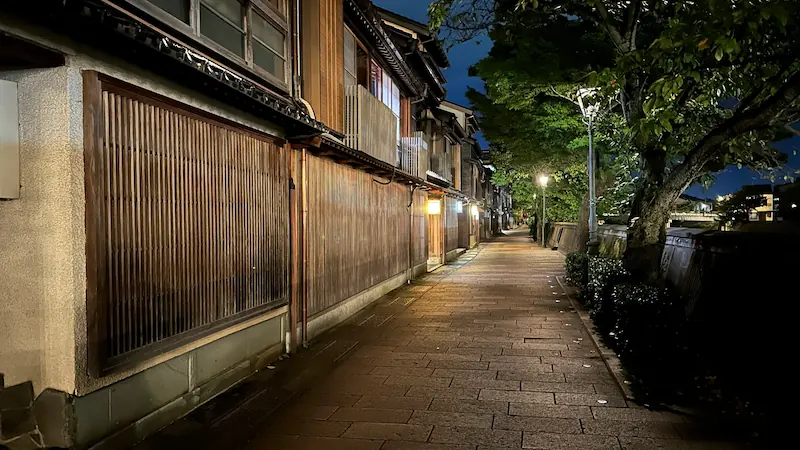
The Kazuemachi Chaya District stretches gracefully along the southern bank of the Asano River and is one of the three major geisha quarters of Kanazawa, alongside Higashi and Nishi Chaya-gai. Established in the early Meiji period, it faces the Higashi district across the river yet preserves a more tranquil and intimate atmosphere. Most teahouses here are two-story wooden buildings, and at night the soft glow filtering through their lattice windows reflects beautifully on the water, creating one of Kanazawa’s most romantic nightscapes.
The district’s name originates from Kazue-no-kami, a Kaga clan official who once resided here, and whose title later lent its name to the neighborhood. Today, traditional teahouses where geisha continue to hone their art still line the narrow lanes, offering a glimpse into the refined elegance and quiet dignity of old Kanazawa.
| Established | Early Meiji Period (around the 1870s) |
|---|---|
| Name Origin | Named after Kazue-no-kami, a Kaga domain retainer |
| Structure & Features | Two-story wooden teahouses along the Asano River, lattice windows, and stone-paved streets |
| Main Landmarks | Nakanohashi Bridge, Kazuemachi Ryokusuien Garden, Kuboichi Ototsurugi Shrine |
| Condition | Well-preserved (some teahouses still in operation) |
| Cultural Designation | Designated Preservation District for Traditional Buildings by Kanazawa City |
| Notes | A district balancing tourism and the ongoing tradition of geisha performance, alongside Higashi Chaya-gai |
🗺 Address: Kazuemachi, Kanazawa, Ishikawa
🚶 Access:
About a 25-minute walk (2 km) or 10-minute bus ride from Nishi Chaya District. From Higashi Chaya District, simply cross the Asanogawa Ohashi Bridge — approximately 3 minutes on foot (0.3 km).
⏳ Suggested Visit Time
Quick stroll: 15–20 minutes
Including night views and bridges: about 40 minutes
📍 Highlights
- Nakanohashi Bridge: A small red bridge connecting Kazuemachi and Higashi Chaya Districts, one of the most photogenic spots in Kanazawa.
- Kuboichi Ototsurugi Shrine: A local shrine beloved as the guardian deity of the geisha community.
- Kazuemachi Ryokusuien Garden: A tiny riverside garden where cherry petals drift over the Asano River in spring.
- Seasonal Beauty: Cherry blossoms in spring, riverside terraces in summer, autumn foliage, and snowy winter charm.
📌 Trivia
- Author Kyoka Izumi Connection: The celebrated writer Kyoka Izumi spent his childhood in this neighborhood; his memorial museum is nearby.
- Nighttime Serenity: After dark, the quiet streets glow softly with light from lattice windows reflected on the river—an ethereal sight.
- Continuing Geisha Tradition: A small number of geisha still perform here, preserving Kanazawa’s refined performing arts culture.
Higashi Chaya District (Higashiyama Higashi Preservation District for Traditional Buildings)
⭐ Recommendation
Historical Value: ☆☆☆
Visual Appeal: ☆☆☆
Experiential Value: ☆☆☆
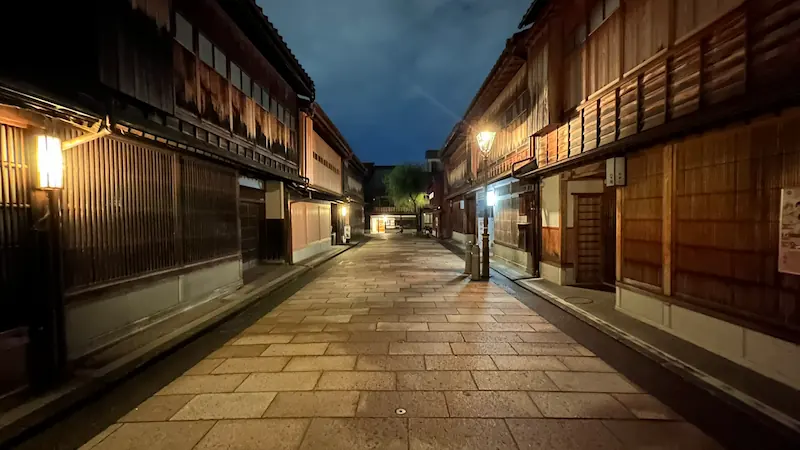
Located on the east bank of the Asano River, the Higashi Chaya District is Kanazawa’s most famous geisha quarter, preserving the refined culture and entertainment traditions of the Edo period. Established in 1820 by the Kaga Domain, teahouses scattered across the castle town were reorganized into a designated entertainment quarter known as the “Eastern Pleasure District.” Over time, it became the cultural heart of Kanazawa’s chaya (teahouse) tradition. Today, it is protected as a National Important Preservation District for Groups of Traditional Buildings, where cobblestone alleys, latticed façades, and elegant wooden townhouses evoke the charm of a bygone era.
| Established | 1820 (Bunsei 3) |
|---|---|
| Founder | Kaga Domain under Lord Maeda Narihiro (12th Daimyo) |
| Structure & Features | Traditional two-story wooden teahouses, latticework façades, second-floor parlors, cobblestone lanes, and uniform street design |
| Preservation Status | Designated as a National Important Preservation District for Traditional Buildings on November 14, 2001 |
| Scale | Approx. 1.8 hectares, with about 140 buildings (around 60% original Edo-style architecture) |
| Historical Changes | Once abolished for moral regulation; later reauthorized in 1867 (Keio 3). Many buildings survived WWII intact and have been carefully restored. |
| Condition | Excellent; now home to teahouses, restaurants, cafes, and traditional craft shops. |
| Notes | “Shima” is a nationally designated Important Cultural Property. Open for daytime visits; other teahouses such as Kaikaro welcome visitors as well. |
🗺 Address: Higashiyama, Kanazawa, Ishikawa
🚶 Access:
Approximately 3 minutes (200 meters) on foot from Kazuemachi Chaya District.
⏳ Suggested Visit Time
Strolling & Exterior Viewing: 30–45 minutes
Including teahouse tours or craft stops: 60 minutes or more
📍 Highlights
- Shima Teahouse: Designated a National Important Cultural Property in 2003. Once an elite entertainment house, it now offers matcha with a view of its serene garden.
- Kaikaro: A lavishly decorated former merchant’s teahouse featuring gold-leaf tatami, Kaga Yuzen fabrics, and lacquered stairways — open for tours during the day.
- Latticed Townhouse Architecture: Fine wooden lattices on the first floor and open ranma-style windows on the second floor exemplify traditional chaya design.
- Stone-Paved Streets: Gently sloped cobblestones enhance the ambiance as you walk through the lanes.
- Evening & Light-Up: After dusk, the soft glow of lanterns, accompanied by distant shamisen or flute sounds, creates a magical atmosphere.
- Traditional Crafts & Gold Leaf Shops: Visitors can enjoy gold-leaf workshops, small craft boutiques, wagashi sweets, and matcha cafés along the way.
- Hiromi Viewpoints: Designated open spaces offering sweeping views of the street and surrounding townscape.
📌 Trivia
- Origins as “Eastern and Western Pleasure Quarters”: The Kaga Domain originally organized entertainment areas into two controlled zones — East (Higashi) and West (Nishi) — to maintain order and decorum.
- Miraculous Preservation: Kanazawa was spared wartime bombing during WWII, allowing its original Edo-period architecture to remain intact.
- Preservation Turning Point: Since its national designation in 2001, local efforts have focused on restoration and maintaining traditional façades.
- Hidden Back Alleys: Beyond the main street, narrow lanes lined with earthen walls and latticed windows reveal the quieter side of the teahouse district.
- Three Teahouse Districts: Kanazawa’s cultural trio — Higashi, Nishi, and Kazuemachi — with Higashi recognized as the largest and most prestigious.
Utasu Shrine
⭐ Recommendation
Historical Value: ☆☆☆
Visual Appeal: ☆☆☆
Experiential Value: ☆☆
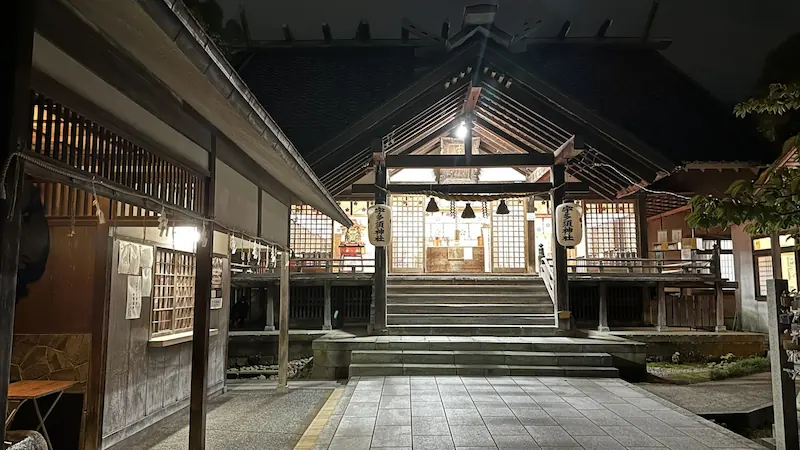
Nestled on a small hill overlooking the Asano River, Utasu Shrine traces its origins to 718 (Yōrō 2) when it was first established as the Utatsu Haruta Tamonten Shrine. In the early Edo period, Lord Maeda Toshinaga enshrined his father Toshiie’s spirit here under the name Utatsu Hachiman-gū, making it the guardian shrine of the Kaga Domain and protector of Kanazawa Castle’s northeast “demon gate.” Following the Meiji-era separation of Shinto and Buddhism, it was renamed Utasu Shrine. Within its peaceful grounds remain legends such as “Lord Toshitsune’s Healing Well,” preserving memories of the Maeda clan in quiet dignity just steps away from the bustle of the teahouse district.
| Year Founded | Traditionally founded in Yōrō 2 (718) / Utatsu Hachiman-gū established in Keichō 4 (1599) |
|---|---|
| Founder / Patron | (Original) Enshrined as Utatsu Haruta Tamonten Shrine / (Utatsu Hachiman-gū) Lord Maeda Toshinaga enshrined Lord Toshiie |
| Structure & Features | Shrine complex with worship hall, main sanctuary, and office; stone-step approach; “Lord Toshitsune’s Healing Well” within the grounds |
| Renovations & Restorations | Renamed in the Meiji era (Takamimusubi Shrine → Utatsu Shrine → Utasu Shrine); elevated to prefectural shrine; ongoing conservation work thereafter |
| Current Condition | Excellent (grounds open for free visitation) |
| Loss & Damage | None in particular (some facilities repaired as needed) |
| Cultural Designation | No formal designation (one of “Kanazawa’s Five Shrines”) |
| Notes | Guardian of the northeastern “kimon” direction; during Setsubun, geisha from the Higashi Chaya District perform dedication dances and bean-throwing rituals |
🗺 Address:1-30-8 Higashiyama, Kanazawa, Ishikawa
🚶 Access
About a 3-minute walk from the Higashi Chaya District (180 m)
⏳ Suggested Visit Time
Quick highlights: about 10–15 minutes
Leisurely visit: about 30 minutes (stone steps, shrine buildings, and well)
📍 Highlights
- Legacy of Utatsu Hachiman-gū: Former domain shrine enshrining Lord Maeda Toshiie — feel the history of Kaga’s guardian deity.
- Lord Toshitsune’s Healing Well: A sacred spring associated with cures; quietly protected behind the main hall.
- Komainu & Shrine Aesthetics: Graceful stone steps and a dignified worship hall set within a photogenic, tranquil grove.
- Seasonal Charm: Cherry blossoms in spring, fresh greenery in summer, and atmospheric evening visits during the lantern-lit Setsubun season.
📌 Trivia
- Mirror Legend: An ancient mirror excavated along the Asano River bore the characters for “U” and “Tatsu,” inspiring the enshrinement of the Utatsu deity.
- Renaming Timeline: Takamimusubi Shrine in 1869, Utatsu Shrine in 1872, renamed Utasu Shrine in 1900, and elevated to prefectural shrine in 1902.
- Kanazawa’s Five Shrines: Beloved locally as one of the “Five Shrines of Kanazawa” alongside Tsubakihara Tenmangū, Utasu Shrine, Kosaka Shrine, Shimmei Shrine, and Yasue Hachiman-gū.
Toyokuni Shrine
⭐ Recommendation
Historical Value: ☆☆☆
Visual Appeal: ☆☆☆
Experiential Value: ☆☆
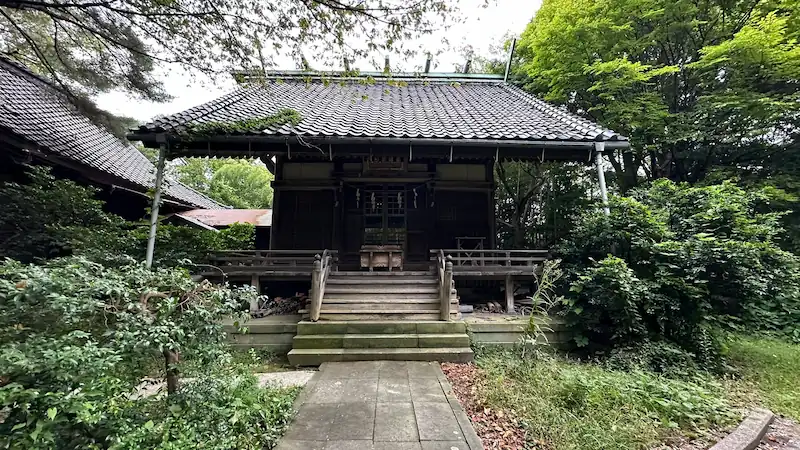
Toyokuni Shrine is dedicated to Toyotomi Hideyoshi, with branch shrines found throughout Japan. In Kanazawa, it stands on the gentle hills of Utatsuyama Park, symbolizing the deep bond between Hideyoshi and Lord Maeda Toshiie, the founder of the Kaga Domain. Although it was difficult to publicly honor Hideyoshi under the Tokugawa shogunate, the shrine was revived during the Meiji period as a gesture of respect toward this historic relationship. Surrounded by tranquil greenery, it offers visitors a quiet place to reflect on the intertwined histories of the Toyotomi and Maeda families.
Panoramic View
| Founded | Originally enshrined in 1616; relocated and revived during the Meiji period (current site since 1907) |
|---|---|
| Structure & Features | Main hall, worship hall, and gate — a typical shrine composition |
| Reconstruction History | Rebuilt several times due to natural disasters and war damage |
| Condition | Small but well-maintained shrine |
| Cultural Status | No special designation |
| Notes | Local worship and annual festivals still observed |
🗺 Address: Suehirozaka, within Utatsuyama Park, Kanazawa, Ishikawa
🚶 Access:
About 20 minutes by Hokuriku Railroad Bus from Kanazawa Station toward Utatsuyama. Get off at “Suehirozaka” or “Utatsuyama Park Entrance,” then walk about 10 minutes.
⏳ Suggested Visit Time
10–15 minutes to explore the grounds and worship hall
📍 Highlights
- Main and Inner Halls: Though modest in scale, the shrine honors Hideyoshi with solemn dignity.
- Festivals: Local residents still hold annual rites and community events.
- Sacred Grove & Approach: The leafy approach and peaceful surroundings make it a refreshing spiritual stop.
📌 Trivia
- Reestablishment under Meiji: Like many Toyokuni Shrines, Kanazawa’s was revived after the Meiji Restoration to honor Hideyoshi, whom the Tokugawa regime had long suppressed.
- Historical Symbolism: Locally, it is regarded as a site symbolizing the friendship between Hideyoshi, Toshiie, and the Maeda family’s enduring loyalty.
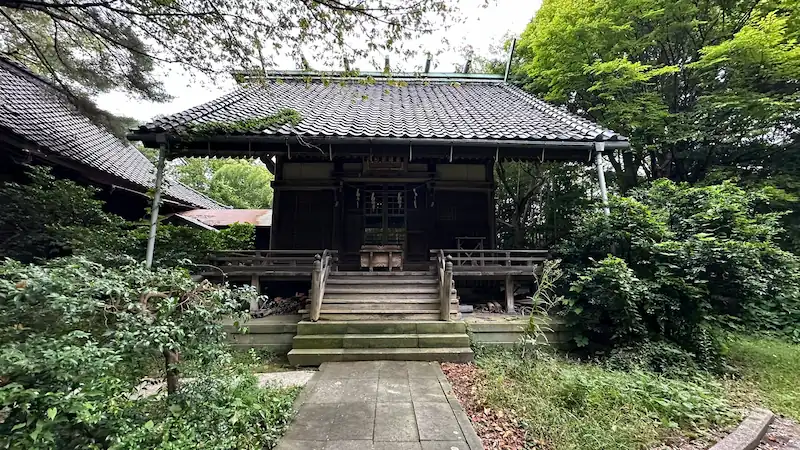


comment